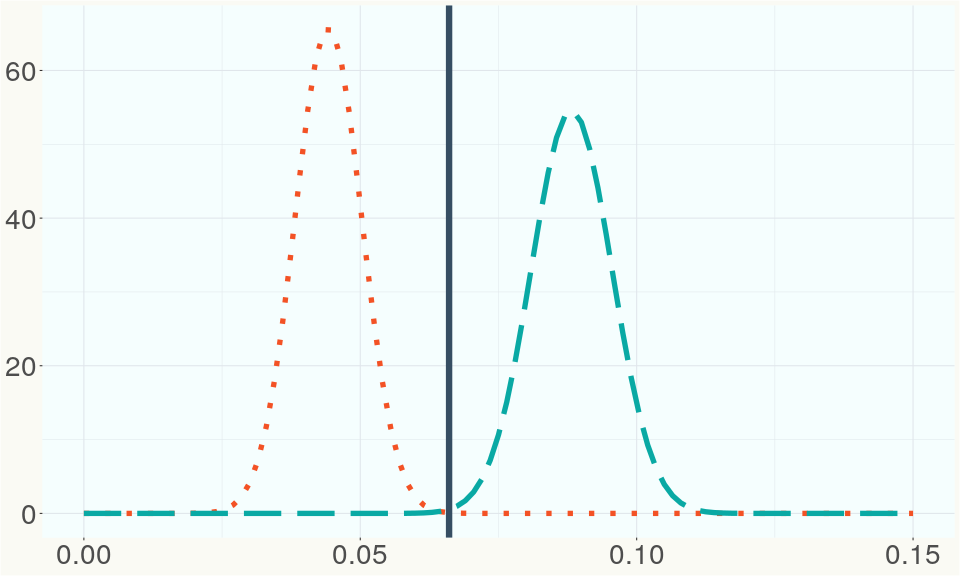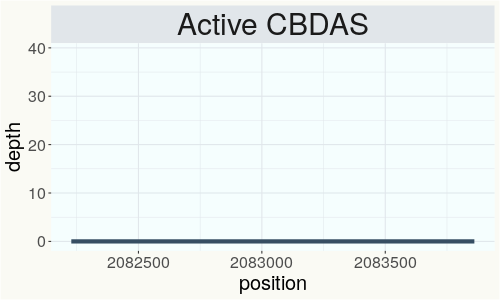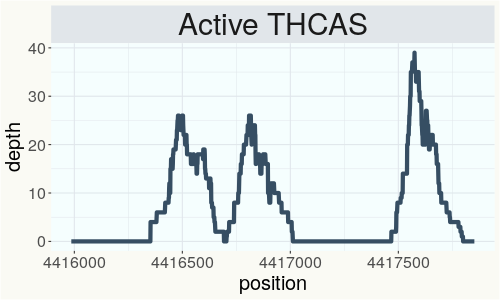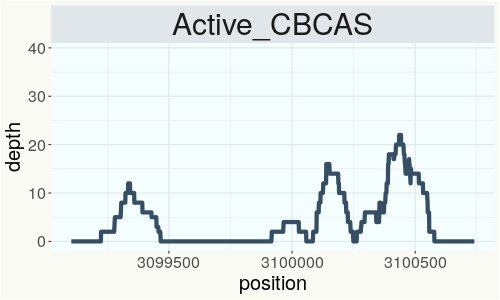Sour Raspberry
RSP 10551
Grower: Sun Simulator Farms
General Information
- Sample Name
- RD-1905-SR_06JAN2017
- Accession Date
- January 5, 2017
- Reported Plant Sex
- Female
- Report Type
- StrainSEEK v2 3.2Mb
- DNA Extracted From
- Flower
The strain rarity visualization shows how distant the strain is from the other cultivars in the Kannapedia database. The y-axis represents genetic distance, getting farther as you go up. The width of the visualization at any position along the y-axis shows how many strains there are in the database at that genetic distance. So, a common strain will have a more bottom-heavy shape, while uncommon and rare cultivars will have a visualization that is generally shifted towards the top.
Chemical Information
Cannabinoid and terpenoid information provided by the grower.
Cannabinoids
- THC + THCA
- 14.94%
- CBD + CBDA
- 0.057%
- THCV + THCVA
- 0.061%
- CBC + CBCA
- 0.194%
- CBG + CBGA
- 0.28%
- CBN + CBNA
- 0.091%
Terpenoids
- α-Bisabolol
- 0.157%
- Borneol
- n/a
- Camphene
- n/a
- Carene
- n/a
- Caryophyllene oxide
- n/a
- β-Caryophyllene
- 0.31%
- Fenchol
- 0.278%
- Geraniol
- n/a
- α-Humulene
- 0.213%
- Limonene
- n/a
- Linalool
- 0.408%
- Myrcene
- 0.165%
- α-Phellandrene
- n/a
- Terpinolene
- 0.146%
- α-Terpineol
- n/a
- α-Terpinene
- n/a
- γ-Terpinene
- n/a
- Total Nerolidol
- 0.443%
- Total Ocimene
- 0.122%
- α-Pinene
- 0.3%
- β-Pinene
- 0.257%
Genetic Information
- Plant Type
- Type I
File Downloads
The bell curve in the heterozygosity visualization shows the distribution of heterozygosity levels for cannabis cultivars in the Kannapedia database. The green line shows where this particular strain fits within the distribution. Heterozygosity is associated with heterosis (aka hybrid vigor) but also leads to the production of more variable offspring. When plants have two genetically different parents, heterozygosity levels will be higher than if it has been inbred or backcrossed repeatedly.
The ratio of reads mapped to Y-contigs to reads mapped to the whole Cannabis genome (Y-ratios) has been demonstrated to be strongly correlated with plant sex typing. This plot shows the distribution of Y-ratios for all samples in our database which were sequenced with the same method (panel or WGS) as this sample and where this sample falls in the distribution.

This chart represents the Illumina sequence coverage over the Bt/Bd allele. These are the three regions in the cannabis genome that impact THCA, CBDA, CBGA production. Coverage over the Active CBDAS gene is highly correlated with Type II and Type III plants as described by Etienne de Meijer. Coverage over the THCA gene is highly correlated with Type I and Type II plants but is anti-correlated with Type III plants. Type I plants require coverage over the inactive CBDA loci and no coverage over the Active CBDA gene. Lack of coverage over the Active CBDA and Active THCA allele are presumed to be Type IV plants (CBGA dominant). While deletions of entire THCAS and CBDAS genes are the most common Bt:Bd alleles observed, it is possible to have plants with these genes where functional expression of the enzyme is disrupted by deactivating point mutations (Kojoma et al. 2006).



This chart represents the Illumina sequence coverage over the CBCA synthase gene.

Variants (THCAS, CBDAS, and CBCAS)
No variants to report
Variants (Select Genes of Interest)
| PKSG-2a | c.67T>A | p.Phe23Ile | missense variant | moderate | contig700 | 1945567 | A/T | |
| PKSG-2a | c.31A>T | p.Thr11Ser | missense variant | moderate | contig700 | 1945603 | T/A | |
| PKSG-2b | c.31A>T | p.Thr11Ser | missense variant | moderate | contig700 | 1951851 | T/A | |
| PKSG-2b |
c.-5_1delATA |
p.Met1del | start lost & conservative inframe deletion | high | contig700 | 1951880 | ATATTAT/A |
|
| aPT1 | c.406A>G | p.Ile136Val | missense variant | moderate | contig121 | 2839605 | A/G | |
| HDS-2 |
c.82_93delGT |
p.Val28_Thr3 |
conservative inframe deletion | moderate | contig95 | 1989748 |
CGTAACCGGAAC |
|
| HDS-2 | c.127T>G | p.Ser43Ala | missense variant | moderate | contig95 | 1989794 | T/G |
|
Nearest genetic relatives (All Samples)
- 0.107 OG BSR (RSP12105)
- 0.206 Super Blue Dream (RSP11011)
- 0.212 Blue Dream (RSP11017)
- 0.218 Blue Dream (RSP11009)
- 0.220 Skunk#3 (RSP12639)
- 0.222 Hermaphrodite Research Sample1 (RSP11042)
- 0.223 Blue Dream (RSP11010)
- 0.226 Hermaphrodite Research Sample1 (RSP11049)
- 0.228 Blue Dream (RSP11006)
- 0.231 RKM-2018-010 (RSP11101)
- 0.234 RKM-2018-009 (RSP11100)
- 0.237 Blue Dream (RSP11342)
- 0.238 Blue Dream (RSP11007)
- 0.241 Serious Happiness (RSP10763)
- 0.242 Blue Dream (RSP11004)
- 0.243 Bordello (RSP11228)
- 0.244 Blue Dream (RSP11012)
- 0.245 Blue Dream (RSP11008)
- 0.247 RKM-2018-028 (RSP11120)
- 0.247 SHERBERT (RSP11355)
Most genetically distant strains (All Samples)
- 0.472 Cherry Blossom (RSP11333)
- 0.468 Cherry Blossom (RSP11328)
- 0.467 Cherry Blossom (RSP11311)
- 0.455 Cherry Blossom (RSP11317)
- 0.454 Cherry Blossom (RSP11324)
- 0.453 Cherry Blossom (RSP11335)
- 0.449 Cherry Blossom (RSP11334)
- 0.447 Cherry Blossom (RSP11308)
- 0.446 Northern Skunk (RSP11456)
- 0.443 Cherry Blossom (RSP11312)
- 0.432 Cherry Blossom (RSP11314)
- 0.432 80E (RSP11211)
- 0.432 80E (RSP11213)
- 0.429 Cherry Blossom (RSP11300)
- 0.429 Cherry Blossom (RSP11309)
- 0.425 Cherry Blossom (RSP11330)
- 0.424 Cherry Blossom (RSP11302)
- 0.419 BagSeed (RSP12627)
- 0.413 80E (RSP11212)
- 0.408 Carmaleonte (RSP11207)
Nearest genetic relative in Phylos dataset
- Overlapping SNPs:
- 7
- Concordance:
- 5
Nearest genetic relative in Lynch dataset
- Overlapping SNPs:
- 7
- Concordance:
- 7
Blockchain Registration Information
- Transaction ID
-
4abeffbe2bacaf3d
307d96db200fd641 8c1db4f060a71866 35eb5a0d076cc936 - Stamping Certificate
- Download PDF (855.8 KB)
- SHASUM Hash
-
ee2953acd06f8eee25289689dfddf2fb c23050db5dec3b1c 7e678a6d5e44af7b